Carnegie Learning Algebra I Student Text Volume 1 3rd Edition Chapter 3 Linear Functions
Page 196 Problem 1 Answer
Given Alexis is a flower vendor who grows and sells her own fresh-cut flowers.
She has a stand in the city, and she distributes flowers to pedestrians during the day.
She charges $ 5 for each flower, and each month she randomly gives away two flowers for free.
We have to write a linear function, a(x) to represent how much money Alexis earns each month.
Use x to represent the number of flowers she sells each month. Write the function in the simplest form.
Remember Alexis earn on x−2 flower every month.
Alexis distributes x flowers every month and each month she randomly gives away two flowers for free
So she earn on x−2 flowers
She charges $ 5 for each flower
Then her total earning is a(x)=5(x−2)
A linear function represents total earning is a(x)=5(x−2).
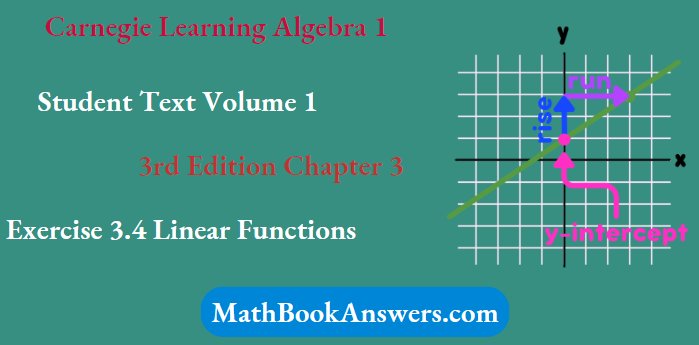
Page 196 Problem 2 Answer
Given Alexis is a flower vendor who grows and sells her own fresh-cut flowers.
She has a stand in the city, and she distributes flowers to pedestrians during the day.
She charges $ 5 for each flower, and each month she randomly gives away two flowers for free.
We have to answer what property did you use to write the simplified form of the function.
Distribute the x.
The function is a(x)=5(x−2)
Use distributive property a(x)=5x−10
Use the distributive property to write the simplified form of the function.
Carnegie Learning Algebra I Chapter 3 Exercise 3.4 Solutions
Carnegie Learning Algebra I Student Text Volume 1 3rd Edition Chapter 3 Exercise 3.4 Linear Functions Page 196 Problem 3 Answer
Given Alexis is a flower vendor who grows and sells her own fresh-cut flowers.
She has a stand in the city, and she distributes flowers to pedestrians during the day.
She charges $ 5 for each flower, and each month she randomly gives away two flowers for free
We have to describe the function. Is it increasing or decreasing and Is it discrete or continuous, and explain our reasoning.
The function is increasing since her earing is increasing as the number of flowers she distributes.
The x must be a whole number, the graph is discrete since the domain is not all real numbers.
The function is increasing since her earing is increasing as the number of flowers she distributes and the graph is discrete since the domain is not all real numbers.
Page 197 Problem 4 Answer
Here we have to complete the table shown.
First, determine the unit of measure for each expression.
Then, describe the contextual meaning of each part of the function.
Finally, choose a term from the word box to describe the mathematical meaning of each part.
input value output value rate of change y-intercept

Expression a(x) addresses the measure of cash she procures so its unit is dollars and its numerical importance is the yield.
Expression 5 addresses the sum she procures per bloom sold so its unit is dollars per blossom and its numerical significance is pace of progress.
Expression x addresses the quantity of blossoms she circulates so its unit is a number of blossoms and its numerical importance is input.
Expression(x−2) addresses the quantity of blossoms she brings in cash from so its unit is blossoms yet it doesn’t have numerical importance (which is the reason the phone is concealed in the table in your book).
Expression−10 is the y-block of the improved on structure a(x)=5x−10. Its unit should then be a similar unit as a(x).
Since the y-block happens when x=0,−10 is the measure of cash she loses when she conveys 0 blossoms.
That is, it addresses the measure of cash she loses from parting with 2 blossoms.
Expression 5x−2 is equivalent to a(x) so it has a similar unit, context-oriented importance, and numerical significance as a(x).
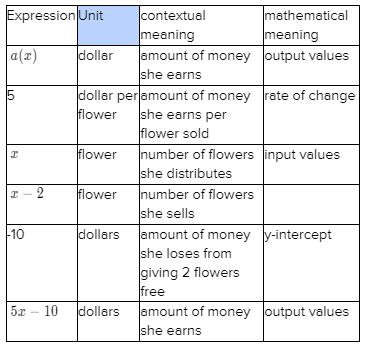
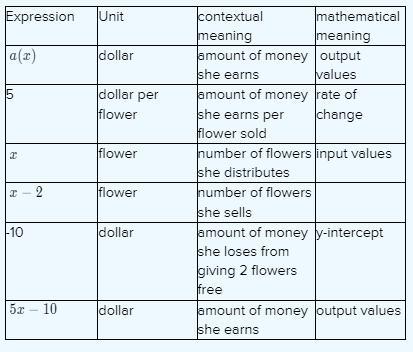
Page 197 Problem 5 Answer
Given Alexis is a flower vendor who grows and sells her own fresh-cut flowers.
She has a stand in the city, and she distributes flowers to pedestrians during the day.
She charges $ 5 for each flower, and each month she randomly gives away two flowers for free.
We have to find how much will Alexis earn in a month if she distributes 45 flowers and show our work.
Substitute x=45 in equation.
The equation for the amount she earn
a(x)=5x−10
Substitutex=45
a(x)=5(45)−10
=255−10
=215
Hence, she earn $215.
If she distributes 45 flowers she earn $215.
Page 198 Problem 6 Answer
Given Bashir is also a flower vendor in a different part of the same city.
He sells flowers for $3 each and gives away 4 flowers for free each month.
He also earns an extra $6 each month by selling one of his homemade bracelets.
We have to write a linear function, b(x), to represent the amount of money Bashir earns each month and be sure to simplify our function.
Remember Bashir earn on x−4 flowers and one of his homemade bracelets.
He sells x flowers and gives away 4 flowers for free each month
So he earn onx−4 flowers
He charges $3 for each flower then he earn 3(x−4) on flower
He also earns an extra $6 each month by selling one of his homemade bracelets.
then the total earing b(x)=3(x−4)+6
simplifying the equation
b(x)=3x−12+6
b(x)=3x−6
A linear function represents total earning is b(x)=3x−6.
Linear Functions Chapter 3 Exercise 3.4 Answers
Carnegie Learning Algebra I Student Text Volume 1 3rd Edition Chapter 3 Exercise 3.4 Linear Functions Page 198 Problem 7 Answer
Given Bashir is also a flower vendor in a different part of the same city.
He sells flowers for $3 each and gives away 4 flowers for free each month.
He also earns an extra $6 each month by selling one of his homemade bracelets.
We have to explain the meaning of the rate of change and the y-intercept of each function.
In Alexis’ functiona(x)=5x−10 here rate of change 5 represents the amount of money she earns per flower and the y-intercept amount of money she lose by giving 2 flowers free.
In Bashir’s functionb(x)=3x−6 here rate of change 3 represents the amount of money he earns per flower and the y-intercept amount of money she lose by giving 4 flowers free but earns $6 from selling braclet.
In Alexis’ function here rate of change 5 represents the amount of money she earns per flower and the y-intercept amount of money she lose by giving 2 flowers free and in Bashir’s function here rate of change 3 represents the amount of money he earns per flower and the y-intercept amount of money she lose by giving 4 flowers free but earns $6 from selling braclet.
Page 198 Problem 8 Answer
Given Bashir is also a flower vendor in a different part of the same city.
He sells flowers for $3 each and gives away 4 flowers for free each month.
He also earns an extra $6 each month by selling one of his homemade bracelets.
We have to compare the units of the: output values, input values, rate of change, andy-intercepts of both functions and what do we notice.
The output value and input value and y-intercept have the same unit of the dollar, the input values have a unit of the number of the flower and the rate of change have unit of dollar per flower both functions have the same unit and positive rate change and negative y-intercept.
After comparing the units we notice both functions have the same unit and positive rate change and negative y-intercept.
Page 199 Problem 9 Answer
Given Bashir and Alexis decide to become business partners and combine their monthly earnings.
They will each continue to sell to their own customers in different parts of the city.
Bashir distributes twice as many flowers each month as Alexis.
We have to find at the end of the month when Alexis and Bashir combine their earnings, about how much will they will earn from each flower sold and explain our prediction.
Find the average of their both they will earn from each flower.
Alexis sells each flower at $5 and Bashir sells each flower at $3.
For combing earning find the average of their both they will earn from each flower.
Thus, 5+3/2
=8/2 =4
Hence, both combine earing is $4.
They will earn $4 from each flower sold.
Carnegie Learning Algebra I Student Text Volume 1 3rd Edition Chapter 3 Exercise 3.4 Linear Functions Page 199 Problem 10 Answer
Given suppose in one month Alexis distributes 20 flowers.
We have to use Alexis’ function to calculate her earnings and show our work.
Substitutex=20 in the equation.
The equation for the amount she earn
a(x)=5x−10
Substitutex=20
a(x)=5(20)−10
a(x)=100−10
a(x)=90
Hence, she earn $90.
Page 199 Problem 11 Answer
Given suppose in one month Alexis distributes 20 flowers.
We have to use Bashir’s function to calculate her earnings and show our work.
Substitutex=40 in the equation.
The equation for the amount he earn b(x)=3x−6
Bashir distributes twice as many flowers each month as Alexis.
So substitutex=40
b(x)=3(40)−6
=120−6
=144
Hence, he earn $144.
If in one month Alexis distributes 20 flowers then from Bashir’s function his earning is $144.
Page 199 Problem 12 Answer
Given suppose in one month Alexis distributes 20 flowers.
We have to find how much money would Bashir and Alexis make together if they combined their earnings.
Find the sum of both they earn.
Alexis earn $90 and Bashir earn $144
So they both combined earning is 90+114=204
Hence, they both combined earning is $204.
Bashir and Alexis combined earnings is $204.
Carnegie Learning Algebra I Linear Functions Exercise 3.4 Solutions
Carnegie Learning Algebra I Student Text Volume 1 3rd Edition Chapter 3 Exercise 3.4 Linear Functions Page 199 Problem 13 Answer
Given suppose in one month Alexis distributes 20 flowers.
We have to use our answer to part (c) to determine the average selling price of each flower after Alexis and Bashir combined their earnings and does this match our prediction Find the ratio of their both earnings and their sold flower.
They both sold a 20+40=60 flower And they combined earning is $204
Then the average selling price is 204/60=3.40
This is less than our prediction.
The average selling price of each flower is $3.40 it is less than our prediction.
Page 200 Problem 14 Answer
Given Nick tried to write a new function, c(x), to represent Alexis’ and Bashir’s combined earnings. He said, “I can add the two functions like this:
c(x)=a(x)+b(x)
c(x)=5x−10+3x−6
=8x−16
Madison disagreed. She said, “That’s not right. You can’t add the functions because the x-values in the two functions don’t mean the same thing, so they might be different values.”
We have to tell who’s correct -Madison or Nick and explain your reasoning.Madison is right.
The x in a(x) addresses the quantity of blossoms Alexis dispersed and the x in $b(x)$ addresses the quantity of blossoms Bashir conveyed.
Since Bashir dispersed twice however many blossoms as Alexis, the worth of x are not the equivalent.
To consolidate the capacities to make c(x), the x in b(x)=3x−6 would need to be supplanted with 2x giving b(x)=3(2x)−6=6x−6 so the x in every situation address similar worth of the quantity of blossoms Alexis dispersed.
Madison is right x represent different values in each function so Bashir sold twice flowers as Alexis.
Page 200 Problem 15 Answer
Here we have to use our answers to Question 4 and Nick’s function to show why his function is not correct and explain our method Use Nick’s function isc(x)=8x−16
where x is the number of flowers they sell.
From Question 4 Bashir and Alexis make together earned $204 and they sell 60 flowers together.
Nick’s function isc(x)=8x−16where x is the number of flowers they sell.
So c(60)=8(60)−16
=480−16
=464≠204
Nick’s function is not correct because c(x)≠204.
Exercise 3.4 Linear Functions Explained
Carnegie Learning Algebra I Student Text Volume 1 3rd Edition Chapter 3 Exercise 3.4 Linear Functions Page 200 Problem 16 Answer
Here we have to answer what does the slope represents in Nick’s function and how does this compare with your answer to Question 4, part (d)The slope of the Nick equation c(x)=8x−16 is 8 it represents the average price per flower.
But in Question 4 , part (d) average price per flower is $4 it does not increase.
In Nick equation is 8 presents the average price per flower but in Question 4, part (d) average price per flower is $4 it does not increase.
Page 201 Problem 17 Answer
Given Nick could actually add the two functions together.
However, he did not recognize that the input values were different for Alexis and Bashir.
To add two functions together, you must ensure the input values represent the same thing in both functions.
A model can be used to represent the input values Let x represent the total number of flowers Alexis and Bashir distribute each month.
The model shows that Bashir distributes twice as many flowers as Alexis each month and that together the number of flowers adds up to x.
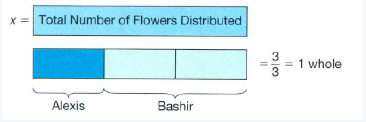
We have to write an expression to represent Alexis’ share of the total flowers distributed.
Then write an expression to represent Bashir’s share of the total flowers distributed.
Let $x$ represent the total number of flowers distributed.
If x is the total number of flowers distributed.
From the model Bashir’s share of the total flowers distributed is 2/3x.And Alexis’ share of the total flowers distributed is 1/3x.
An expression to represent Alexis’ share is 1/3x and Bashir’s share is 2/3x.
Page 201 Problem 18 Answer
Given Nick could actually add the two functions together. However, he did not recognize that the input values were different for Alexis and Bashir.
To add two functions together, you must ensure the input values represent the same thing in both functions.
A model can be used to represent the input values.
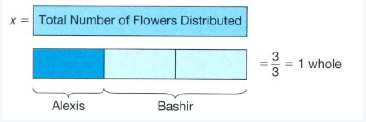
We have to rewrite Alexis’ and Bashir’s functions so they show each person’s share of the total earnings.
Then, add the functions to determine a new function, c(x), that describes the combined amount of money Alexis and Bashir earn each month and show our work.
Replace x with in the Alexis function with1/3x and with 2/3x in the Bashir equation.
Then add both equations.
The Alexis function a(x)=5x−10
Replace x with 1/3x in the Alexis function right side
a(x)=5(1/3x)−10
a(x)=5/3
x−10
The Bashir equation b(x)=3x−6
Replace x with 2/3x in the Bashir equation right side
b(x)=3(2/3x)−6
b(x)=6/3
x−6
Now add both equations for the total earnings.
c(x)=a(x)+b(x)
=5/3x−10+6/3x−6
=11/3x−16
≈3.67x−16
Alexis’ person’s share equation is a(x)=5/3x−10, Bashir person’s share equation is b(x)=6/3x−6 and the combined equationc(x)=3.67x−16.
Page 201 Problem 19 Answer
Given Nick could actually add the two functions together.
However, he did not recognize that the input values were different for Alexis and Bashir.
To add two functions together, you must ensure the input values represent the same thing in both functions.
A model can be used to represent the input values.
Let x represent the total number of flowers Alexis and Bashir distribute each month.
The model shows that Bashir distributes twice as many flowers as Alexis each month and that together the number of flowers adds up to x.
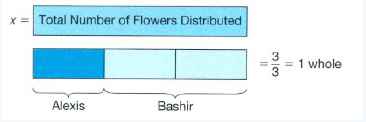
We have to answer what does the slope of the new function mean and what does the y-intercept of the new function meanThe new function is c(x)=3.67x−16
where the slope of the equation is 3.67 it represents the average rate per flower and the y-intercept is -16 it represents the total amount of flower they in give free.
The slope 3.67 it represents the average rate per flower and the y-intercept is -16 it represents the total amount of flower they give free.
Chapter 3 Exercise 3.4 Carnegie Learning Guide
Carnegie Learning Algebra I Student Text Volume 1 3rd Edition Chapter 3 Exercise 3.4 Linear Functions Page 202 Problem 20 Answer
Given Alexis and Bashir decide to partner with an investor.
The investor will supply money for equipment, flower seeds, and other materials. In return, the investor will receive $ 0.50 for every flower distributed.
We have to answer In this case, why was it possible to determine a new function without rewriting d(x).
In both functions, x represents the total number of flowers they distribute so they have the same input values that’s why it was not we can write a new function without rewriting d(x).
Both functions have the same input values that’s why it was not we can write a new function without rewriting d(x).
Page 202 Problem 21 Answer
Given Alexis and Bashir decide to partner with an investor.
The investor will supply money for equipment, flower seeds, and other materials.
In return, the investor will receive $ 0.50 for every flower distributed We have to think about each problem situation and compare the functions t(x) and c(x) and what do we notice.
The functions t(x)=3.17x−16 and c(x)=3.67x−16.
They both have a y-intercept means the amount flower they give free it’s not affected by the amount.
The slope t(x) is 0.05 less than c(x)because the investor has a share 0.05 per flower.
They both have a y-intercept and The slope t(x) is 0.05 less than c(x).
